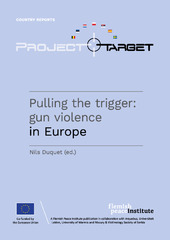Приказ основних података о документу
A snapshot of illicit firearm-trafficking and gun violence in Serbia
| dc.creator | Ćopić, Sanja | |
| dc.creator | Dokmanović, Mirjana | |
| dc.date.accessioned | 2023-03-12T13:12:30Z | |
| dc.date.available | 2023-03-12T13:12:30Z | |
| dc.date.issued | 2022 | |
| dc.identifier.isbn | 9789464074192 | |
| dc.identifier.uri | http://rfasper.fasper.bg.ac.rs/handle/123456789/5086 | |
| dc.description.abstract | The uncontrolled spread and misuse of firearms challenges and threatens both State and human security. According to the Small Arms Survey estimates, there are more than one billion firearms in the world, the vast majority of which are in the possession of civilians.1 Although Serbia is among the top-ranked countries according to the estimated rate of civilian firearm holdings,2 the country is not characterised by high levels of conventional crime or violence with firearms. As suggested by the Small Arms and Light Weapons (SALW) survey, the period 2012–2016 saw a 34% decrease in criminal offences committed with the use of firearms.3 In the period from 2010 to 2015, approximately 260 deaths in Serbia annually resulted from firearms4 which include approximately 52 firearm homicides annually (an annual average of 0.73 firearm homicides per 100,000 population). On the other hand, the problem of trafficking in and illicit possession of firearms is also present in Serbia: most cases of homicide and other violent crimes are committed using illicit firearms. However, apart from some studies of small arms and light weapons (SALW) and domestic violence,5 no specific studies have been undertaken to analyse the impact of illicit firearm-trafficking – particularly as a form of organised crime – on gun violence in Serbia in general. Consequently, little is known about the scope and dynamics of the impact of illicit firearm-trafficking on gun violence. Taking that as a starting point, the objective of the present study is to analyse the impact of illicit firearm-trafficking on gun violence in Serbia. The study has three main aims: • to analyse the scope and nature of gun violence in Serbia; • to analyse the characteristics of firearms used in gun violence in Serbia, and • to map out existing policy and practice related to collecting and recording data in this area, preventing gun violence, combating illicit firearm-trafficking and limiting the impact of illicit firearm-trafficking on gun violence. | sr |
| dc.language.iso | en | sr |
| dc.publisher | Brussels: Flemish Peace Institute | sr |
| dc.rights | openAccess | sr |
| dc.rights.uri | https://creativecommons.org/licenses/by/4.0/ | |
| dc.source | Pulling the trigger: gun violence in Europe | sr |
| dc.subject | gun violence | sr |
| dc.subject | firearm trafficking | sr |
| dc.subject | research | sr |
| dc.subject | Serbia | sr |
| dc.title | A snapshot of illicit firearm-trafficking and gun violence in Serbia | sr |
| dc.type | report | sr |
| dc.rights.license | BY | sr |
| dc.citation.spage | 265-314 | |
| dc.identifier.fulltext | http://rfasper.fasper.bg.ac.rs/bitstream/id/10110/jghjd.pdf | |
| dc.identifier.rcub | https://hdl.handle.net/21.15107/rcub_rfasper_5086 | |
| dc.type.version | publishedVersion | sr |


